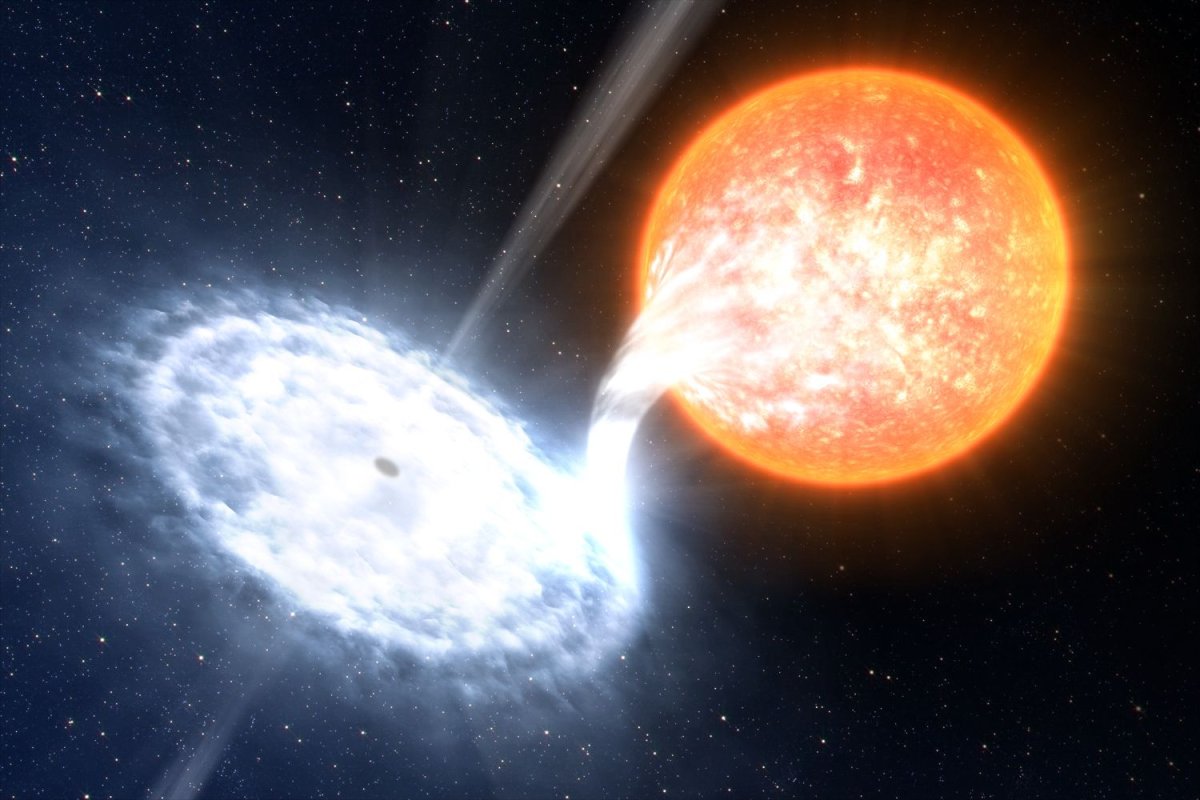Astronomers are baffled by a strange jet of particles shooting from a black hole. Observations of the unusual flare contradict current models of black holes and their powerful magnetic fields—potentially challenging everything we know about these mysterious regions of space.
Published today in Science, data from the V404 Cygni black hole system suggest magnetic fields are much weaker than physicists believed. To account for this research, black hole theories will need to be rewritten, scientists suggest.

"From simple compasses to cell phones in our pocket—even satellites operating around the Earth—understanding the magnetic field is essential," lead author Yigit Dallilar, from the University of Florida, told Newsweek. Groups of particles create fields charged with positive and negative forces. As you probably know from the magnets on your fridge, these forces can pull objects together or push them apart.
On a larger scale, magnetic fields cause strange and mysterious events around the universe. Stunning auroras light up Uranus every day when its magnetic field flips. If Earth's field reversed, magnetic north and south would go haywire.

Magnetic fields wield enormous power for black holes too, but scientists have a poor understanding of their role.
Dallilar and his team mapped V404 Cygni's magnetic field using observations of the outburst event. As its jet flare cooled, they calculated a precise model of the strength of the field surrounding the black hole. Their data revealed a much weaker magnetic field than current theories predict.
Coronas, jets and accreting disks

V404 Cygni's black hole sits approximately 8,000 light years from Earth. The system is currently sucking matter from a neighboring star.
While black holes themselves are completely dark, visible matter can collect around them—producing some of the brightest light in the universe. These glowing rings of spinning matter are called "accretion disks."
Avi Loeb, chair of Harvard University's Astronomy Institute and Director of the Black Hole Initiative, who was not involved in the study, told Newsweek that matter falls into a black hole from this disk like water spirals down the sink of a bathtub.
Friction from turbulent magnetic fields is theorized to force matter out of rotation and into the middle of the black hole, he explained. At this point of "singularity," everything is crushed into an infinitely tiny point.

Magnetic fields are theorized to govern something called the "corona" of a black hole, where highly energetic particles swirl in hot gas above the accretion disk. When magnetic fields shift the corona, the cloud of particles can create a jet of matter moving almost at the speed of light, as pictured in the image above.
The magnetic field acts like a slingshot, "giving rise to a powerful wind or a jet, often moving out close to the speed of light," Loeb said. "We do not know how the corona forms or gets replenished or what heats it. We need better numerical simulations of these corona."
Models need re-thinking
The new results from V404 Cygni call current models of jet emissions, accretion disks and coronas into question.
"These models typically talk about much larger magnetic fields at the base of the jet, which many assume to be equivalent to the corona," Dallilar explained. "Our results indicate that these models might be oversimplified. Specifically, there may not be a single magnetic field value for each black hole."
Magnetic field origins

Black holes themselves cannot create magnetic fields like the one observed in this research. "Black holes alone possess negligible electromagnetic charge and don't have magnetic poles," Dallilar said. "The required magnetic field is either accumulated from surroundings via accreting material, or simply generated within the accretion flow."
In other words, magnetic fields are governed by the environment around a black hole. Scientists don't really understand exactly how these fields come to exist—which only adds to the mystery surrounding jet flares.
"Black holes are important test laboratories to study general relativity, accretion physics, jet formation and other micro-processes therein," Dallilar said. "The uncertainty in magnetic field is one of the many challenges to understanding how these systems work."
"This data can serve as the basis for a detailed theoretical simulation of the conditions in the immediate vicinity of this black hole," Loeb said. "By studying systems such as V404 Cygni, we acquire better understanding of the behavior of matter under these extreme conditions."
Uncommon Knowledge
Newsweek is committed to challenging conventional wisdom and finding connections in the search for common ground.
Newsweek is committed to challenging conventional wisdom and finding connections in the search for common ground.
About the writer
Katherine Hignett is a reporter based in London. She currently covers current affairs, health and science. Prior to joining Newsweek ... Read more
To read how Newsweek uses AI as a newsroom tool, Click here.








